
Continuing my Manhattan cross streets series. I’ve done them piecemeal in the past, but I’ve already posted 20th Street, 22nd Street and 17th Street in this batch, and 14th Street as well in autumn 2019 with more to follow. Today’s entry: 10th Street, Part 2: East 10th.
Before the Great Infection, I spent a number of Saturdays (and some Sundays too) crisscrossing Manhattan via its numbered streets. Over the years, I’ve done this quite a few times and I was amazed at how much stuff I missed and how much material I knew about and posted here and there, but never really formalized or categorized. Eventually I might make these “crosstown” posts their own separate category. I’ve already posted much of 11th, 12th, 13th, and 14th (twice) and before I get tired of this, I might just do every one of NYC’s numbered crosstown streets, since I had so much fun finding things I never knew about and revisiting things that I did.
After I finish the streets I walked during this time, I’ll add a strip link to all those pages.
A word about the Great Infection. So far I’m more concerned about what it’s done or will do to my investments (which are modest to begin with) but in mid-March, I was admonished to stay indoors after my Facebook photo posts of meandering around Woodside and Sunnyside were seen. Just to be on the safe side, I’ll have to confine myself close to home the next few weeks (months, maybe), whether or not I get ill. I hope everything’s back to normal—healthily and financially—before too much longer! As of April 25, I remain Covid-free.
I like this building at #7 East 10th so much, I have two separate photo galleries of it.
This is officially the New York University Edgar M. Bronfman Center for Jewish Student Life, a regular 5-story brick townhouse — with an intricately, beautifully and painstakingly carved teakwood bay window. The window treatment is the work of Lockwood de Forest (1850-1932), a painter, artist and decorator, a contemporary and occasional collaborator with decorative glass pioneer Lewis Comfort Tiffany. Partnering with Tiffany in the design firm Associated Artists in 1879, an influential design firm that helped spearhead the American Esthetic movement, de Forest directed the production of architectural woodwork.
Visiting India on his honeymoon that year, de Forest collected furniture, jewelry and textiles and became a passionate fan of Far Eastern design, which became highly influential on his own work, attracting the attention of heavy hitters like Andrew Carnegie, whose bedroom and library he designed in what is now the Cooper-Hewitt Museum. He purchased #7 East 10th Street in 1887 and, with architect Van Campen Taylor, proceeded to decorate it with intricately carved teak elements produced in India.
De Forest sold the house and moved to Santa Barbara, CA in 1922, and over time its interior teakwork was removed and sold at auction. But when NYU acquired the building in 1994, much of the woodwork was lovingly restored. It remains a one-of-a-kind address. Except, perhaps, for the building next door!
#9 East 10th Street next door is another 5-story brick townhouse, and while at first glance it doesn’t look as magnificently decorated as its next door neighbor, a closer look reveals some surprises. It, too, has ornamental teakwork: in an ornamental square identifying the building as The Ava, around the dors and windows, and in the cornice just below the roof. It was constructed in 1888 by architect William H. Russell and his firm, Renwick, Aspinwall & Russell. Undoubtedly, explains the NY Times‘ late great Christopher Gray, he used some teak from de Forest’s factory.
#9 East 10th was one of novelist, diarist, and playwright Dawn Powell‘s several Greenwich Village addresses.
In her diaries, she expressed her joy of landing in bohemian Greenwich Village, “where all night long typewriters click, people sing in the streets, hurdy gurdies go all day and the laundry boy reads Turgenev.” The New Yorker
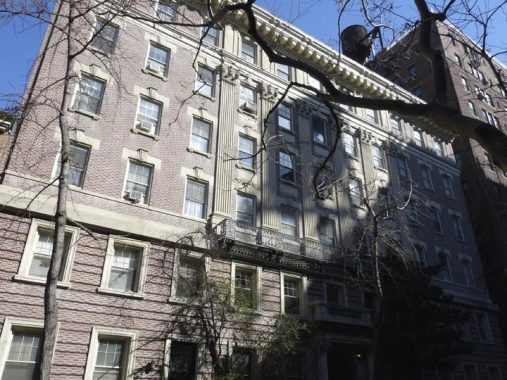
The Mayfield, at 15 East 10th Street, was built in the 1920s and is described as a “Collegiate Gothic” building. It is distinctive with its six massive Corinthian pilasters (columns attached to the exterior).

Oh those midwinter shadows, playing havoc with my shot of 21 East 10th (The Wordsworth) at University Place. According to NY Songlines‘ Jim Naureckas the building was where Amorino, the super-rich Italian hot chocolate, was invented; it has also been home to Perfect Storm adventure author Sebastian Junger. For the old timers, the building was used in exteriors for the 1950s sitcom the Ann Sothern Show.
This is the 1924 addition to the former Hotel Albert, at the SE corner of University Place and East 11th Street. The original section one block north at West 11th was constructed in 1883 by architect Henry Hardenburgh, whose most famous work is likely the Plaza Hotel at 5th Avenue and Central Park South. It was completed by additions in 1904 and 1924. Originally called the St. Stephen, it was thought it acquired the name Hotel Albert because of its association with painter Albert Pinkham Ryder, who was a frequent visitor, but the name came from the hotel’s owner, Albert Rosenbaum.
Over the years the Hotel Albert gained a reputation for bohemian and cultural figures that stayed there. In that way, it could be called the Hotel Chelsea of its era. Mark Twain, an East Village fixture, gave lectures at the hotel while Hart Crane wrote his paean to the Brooklyn Bridge (“The Bridge”) while staying there. Anaïs Nin, Jackson Pollock, Rocky Graziano, and the Mamas & The Papas were all patrons. In the 1970s, it slipped into decrepitude and became an SRO, but it was revived into condo-hood a decade later.
The older part of the hotel faces West 11th at University Place.
So nice, I shot it twice: Grace Church, one of NYC’s greatest, not least because of its propitious position at a band in the road at Broadway and East 10th.
Grace Church, at Broadway and East 10th, is visible when you are looking north on Broadway because of a bend in the road caused by the intransigence of one man: Henry Brevoort, who owned an orchard and refused to budge when the streets were being routed through according to the Randel Plan in the early 19th Century. Broadway was diverted northwest, joining the old Bloomingdale and Kingsbridge Roads uptown, and 11th Street never went through from Broadway to the Bowery Road (today’s 4th Avenue).
This gave the trustees of Grace Episcopalian Church, which had been instituted in 1808, a chance to move uptown from the Wall Street area in 1846 on land purchased from Brevoort and build a massive Gothic Revival church building at Broadway and 10th, with James Renwick Jr. the architect at only 23 years of age. Renwick would go on to design St. Patrick’s Cathedral, but many say this is his greatest achievement. Like the Cathedral of St. John the Divine on 110th Street and Amsterdam, Grace Church is never really finished and has been constantly added to over the years.
The garden on church grounds at Broadway and 10th was once the site of Fleischmann’s Vienna Model Bakery, the Applebee’s of the mid-19th Century. Here’s a menu.
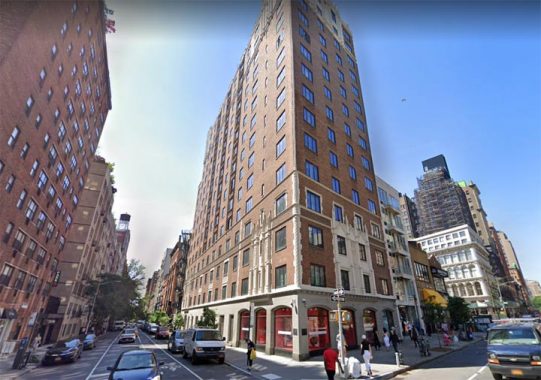
The Gothic touches on the former Hotel Brittany, NW corner of Broadway and West 10th, are no accident. They were deliberately baked into the cake when the hotel was designed and built across the street from Grace Church in 1922. It has been home to uber-columnist Walter Winchell (the inspiration for J.J. Hunsecker in Sweet Smell of Success), actor Al Pacino and even Head Deadhead Jerry Garcia.

I may have mentioned I’m a big fan of white-bricked buildings and here at 4th Avenue and East 10th Street are a pair of massive ones, #60 and #70 East 10th Street. #70 is called Stewart House, as this is the site of the former Alexander Turney Stewart Cast Iron Palace, one of NYC’s first large department store. The Irish-born Stewart (1803-1876) was a retail store pioneer; his marbele-fronted building at Broadway and Chambers Street still stands, as well as his home on (fittingly) Commerce Street in the Village. He is one of the few people who have ever had their corpse stolen and held for ransom. His rem ains were removed from St. Marks’ Churchyard a couple of blocks away in 1878 and held for $20,000; when the ransom was paid in 1881, the body was returned. Without refrigeration in that era, things must have gotten odiferous for the kidnappers.
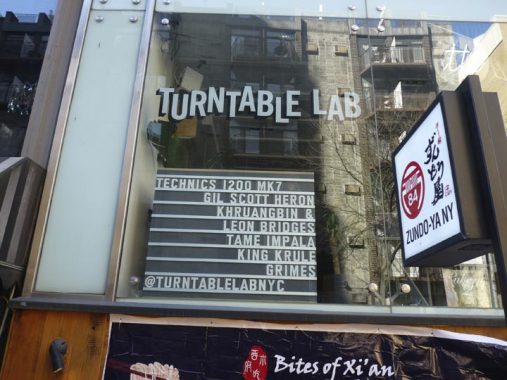
Turntables and vinyl records never went away — they’re still used by party DJs and have been making a comeback in regular consumer use. Turntable Labs, #82 East 10th between 3rd and 4th Avenues…
For years I would make a pilgrimage to #86 East 10th Street…because it had the upper part of a Type 1 BC bishop crook lamp illuminating the basement entrance. Alas, the Crook disappeared several years ago [Bob Mulero photo]

East of 3rd Avenue, #109-117 East 10th, a group of Italianate attached townhouses constructed in 1856. Note that some have preserved their detailing and some haven’t.
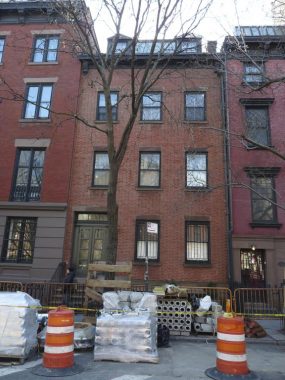

Just short of 2nd Avenue, East 10th Street makes a V with Stuyvesant Street, the only street in Manhattan oriented due east and west. It is the last remnant of the Peter Stuyvesant farm and once served as the driveway (for horses and carts) between the Bowery Road (now 4th Avenue) and the farm, which was northeast of 2nd Avenue and 10th.
Mr. Stuyvesant’s Garden: the Story of Stuyvesant Street
Return to Stuyvesant Street
Above, 44 Stuyvesant Street was built in 1795 for Nicholas William Stuyvesant, according to Landmarks, and is one of two remaining houses that belonged to the Stuyvesant family from the immediate post-Revolutionary era. Only the Morris-Jumel Mansion in Sugar Hill is an older residential building on Manhattan Island. It carries no historic plaque and blends in well with the surrounding buildings, which go back to the 1840s-1850s.
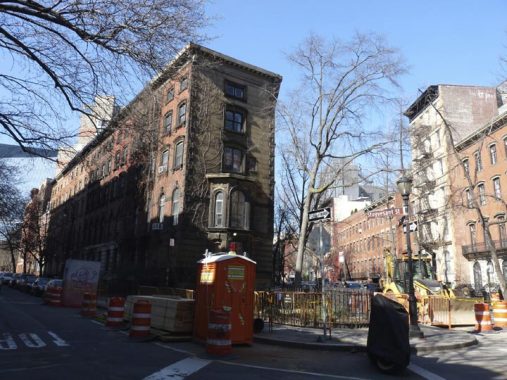
Abe Lebewohl Triangle, Stuyvesant Street and East 10th. The longtime owner of the 2nd Avenue Deli (he founded it on the SE corner of 2nd Avenue and East 10th in 1954) was shot and killed in an unsolved robbery on March 4th, 1996. The deli closed at its original location, but later reopened in two Midtown and East Side locations, 162 East 33rd and 1442 1st Avenue.
St. Mark’s Church, 2nd Avenue and East 10th Street, located close to where the Stuyvesant farmhouse had been. It was built in 1799 and is the second oldest church building in the city (the oldest being St. Paul’s Chapel at Broadway and Fulton Streets). It stands on the chapel site of Peter Stuyvesant’s 17th Century estate (the Director-General is interred in a vault in the churchyard, as his great-grandson sold the property to the Episcopal Church in 1793) and is turned to face Stuyvesant Street, once the driveway to the estate. NYC mayor and diarist Philip Hone and NYS Governor and US Vice President Daniel D. Tompkins are also interred in the churchyard.
As you can see the church is angled away from East 10th Street. It follows the old course of Stuyvesant Street. Long ago, Stuyvesant Street extended to 2nd Avenue and before the street grid was constructed in the 1810s and 1820s, it extended even further.
Stuyvesant was interred in the family vault beneath the chapel when he died in 1672. During the 18th century, the chapel fell into a state of dilapidation, until little remained except the foundation and the Stuyvesant family vault beneath. In 1793, Stuyvesant’s great-grandson, Peter Stuyvesant IV, donated the chapel property to the Episcopal Church with the stipulation that a new church be erected. Originally intended to be a chapel of Trinity Parish, St. Mark’s in-the-Bowery was completed in 1799 as the first New York City Episcopal parish separate from Trinity. The Stuyvesant vault is still present under the east wall of the church; it was closed permanently when the last family member was interred there in 1953.
Moving across the street to 2nd Avenue and East 10th, I stopped in front of the bank that was previously occupied by the 2nd Avenue Deli. As mentioned, the deli moved uptown to two separate locations after the unsolved murder of its founder, Abe Lebewohl. Two triangles on either side of east 10th and Stuyvesant street are named for him. One remnant of the Deli can be found here still.
The sidewalk still boasts The Walkway of Yiddish Actors, an homage to the old “Jewish Rialto”, a collection of theaters and entertainment venues on 2nd Avenue, two of which, the Orpheum and the present Village City Cinemas, yet stand. The Walkway was installed in 1984 by deli owner Lebewohl. The names Fyvush Finkel and Molly Picon may be recognizable to American audiences from their TV appearances over the years. Fyvush is Yiddish for Philip.
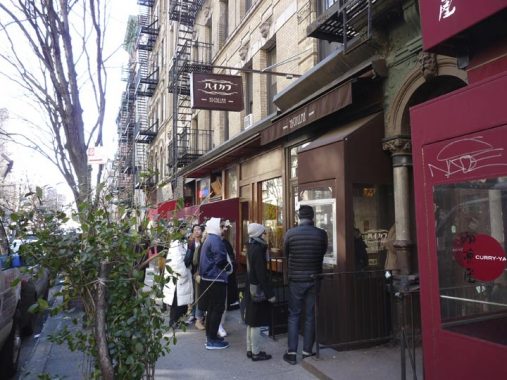
Often, there is hidden history in restaurant names. I was unaware that there is a small Japanese enclave in the East Village concentrated along East 9th and 10th Streets. One of the restaurants is called Hi-Collar (at #214) and proprietor Bon Yagi named it for a group of late 19th Century Japanese dandies who wore high collars, in imitation of British fashion in the period. There was a line down the street, and good reviews must have preceded the crowd.
I am attracted to any building that has ample ornamentation, like 229 East 10th. The 5-story tenement was built in 1889 by architects Schneider and Harter. It was an apartment building from the beginning, originally home to 21 families. I enjoyed all the carvings, with heads on the window lintels and cherubs supporting the pediment columns on the top floor. But who is supporting the cherubs? A figure sculpted to resemble Frederick Douglass!
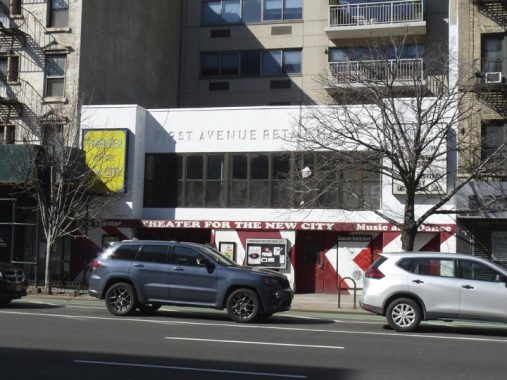
The First Avenue Retail Market, with its just-the-basics design, was one of a number of retail markets set up by the LaGuardia Administration in the 1930s as a way of controlling the proliferation of pushcarts on the streets, which he claimed were unsanitary. There are others scattered around town, such as the Arthur Avenue Retail Market in Belmont, the 13th Avenue Retail Market in Borough Park, Brooklyn and the Essex Street retail Market on the Lower East Side, likely the largest, which was recently closed and relocated to the Essex Crossing development along Delancey and Essex Streets.
I have a feeling we’ll be giving sanitary considerations a fresh look in the early 2020s. Theater for the New City, an organization promoting new playwrights, now occupies the space. In 2001, a 16-story residential tower was constructed atop the old market building.
Until 1942, the 2nd Avenue El rattled above. The 2nd Avenue El on 1st Avenue? Yes. It jogged west one block at East 23rd.
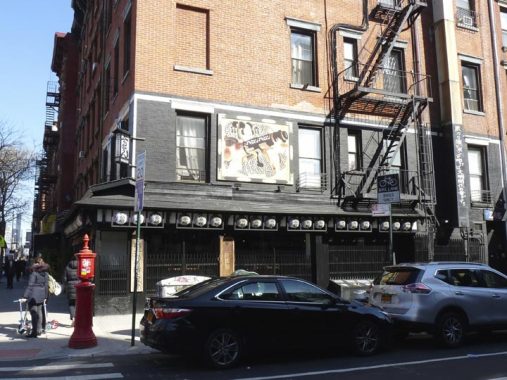
A mystery. I have mentioned East 10th in the East Village is a Japanese enclave. Here at #164 1st Avenue on the corner is Beron Beron, with Japanese art and Japanese script.
I had thought that this was the last public bathhouse remaining in NYC (turns out there are other more recent ones). The Russian & Turkish Baths at #268, as the sign says, has been here since 1892. The entranceway is a relatively new renovation: here’s how it appeared in 1940. Admission for one isn’t cheap: $48.00. I’ve never been in a sauna, and I’m curious about it. This one has a restaurant. Based on the video, it has an old school vibe quite unlike modern examples.
Like other east-west streets in the East Village, small retail businesses and restaurants have arrived on the ground floors of residential buildings constructed between 1880-1915. Some continue the area’s Japanese theme.
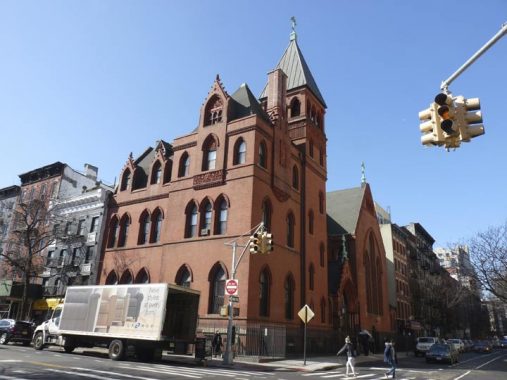
I couldn’t do much about the truck spoiling my shot of the Saint Nicholas Carpatho Russian Orthodox Greek Catholic Church, Avenue A and East 10th. When constructed in 1883 the Gothic Revival building was a chapel for nearby St. Mark’s Church (see above), 2nd Avenue and East 10th, but was purchased by Eastern Orthodox faithful in 1925. The architect was James Renwick Jr., a pre-eminent ecclesiastical architect best known for St. Patrick’s Cathedral on 5th Avenue.
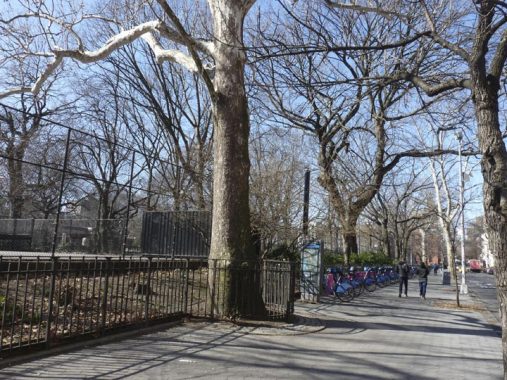
Between Avenues A and B, East 10th runs along the north end of Tompkins Square Park. However, it borders the least interesting end of the park, separated by a fence and bushes from the playgrounds and basketball courts, so I’ll eschew discoursing on the park here, though I have done so elsewhere in FNY:
Tompkins Square Park, Squalor to Oasis
Five Squares Part 2: Stuyvesant to Tompkins
As you may expect the streets facing the park were prime territory for developers, #297 and 299 East 10th were built in 1846 with the upper stories added in 1893. They were built in an Italianate style with later Queen Anne elements at the roofline. I was attracted to the building by the metal sign for “Doctor I. Grossman,” who owned the building during the 1930s.
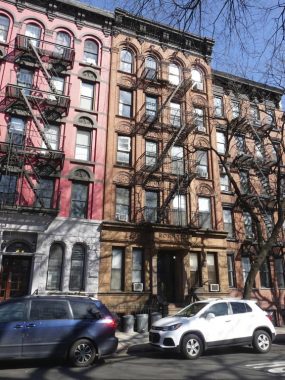
I have been drawn to #323 East 10th in the past, likely on a rainy day, when its brick and brownstone exterior looked inviting to me. The name “Bonsall” appears over the door, likely the first owner or developer when it was built in the mid-19th Century. Robert Bonsall and his family owned several parcels on this block beginning in the 1840s.
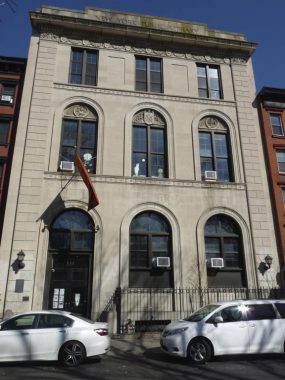
This is the Tompkins Square Public Library on East 10th between A and B, one of the many libraries instituted via a grant from steel magnate/philanthropist Andrew Carnegie, built by McKim, Mead & White, 1904. The rosettes above the 2nd floor windows honor NYC’s early Dutch settlers, as well as pioneering printers, including Aldus Manutius and Cristophe Plantin, major early names in the art. (Plantin, a font used by the Village Voice for many years, was named for him.) I have a soft spot for buildings and streets that honor printing, since I’ve always worked in typesetting and printing. Namely, the former Evening Post building on Vesey Street at St. Paul’s Churchyard. There are also some Bronx streets that honor printers, like Aldus Street and Hoe Avenue (for Colonel Richard Morris Hoe, who invented a variety of printing press).
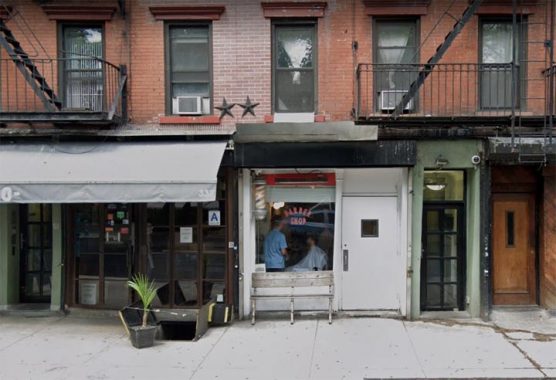
Just a bit off the top, please, at this just the basics barber shop at #339 East 10th. It has a secret, though: a “speakeasy” called Blind Barber can be found within.
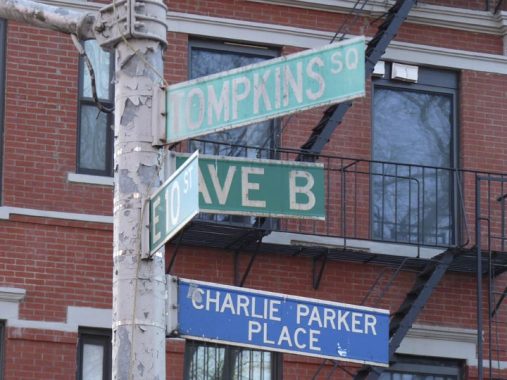
That’s a lot of street signs at Avenue B and East 10th, and all of them are approaching 40 years old, as the first generation of green and white street signs. In the early days, signs honoring people were white on blue, and some older examples can still be found around town. Charlie Parker (1920-1955), the great jazz saxman considered to be the father of bebop, lived at #151 Avenue B. In the biz he was known as “yardbird” possibly inspiring the British rock band’s name, and then as simply “Bird.” He was played by Forest Whitaker in a biographical movie directed by Clint Eastwood in 1988.

A bistro on the NW corner of Avenue B and East 10th is called Maiden Lane; this is the actual name of a street in the Financial District, so named because in the Dutch colonial era it overlaid a stream in which local women would come to do laundry, or so some stories have it. The name has been popular and streets in other municipalities are named Maiden Lane, as well. The bistro is apparently named for the Maiden Lane in London. I wonder which came first?

What was originally PS 64, designed by prolific early 20th Century schools architect C.B. J. Snyder, is likely the largest disused school building in NYC. It sits abandoned and graffitied, between East 9th and 10th Streets east of Avenue B until a developer either demolishes it or rehabilitates it.
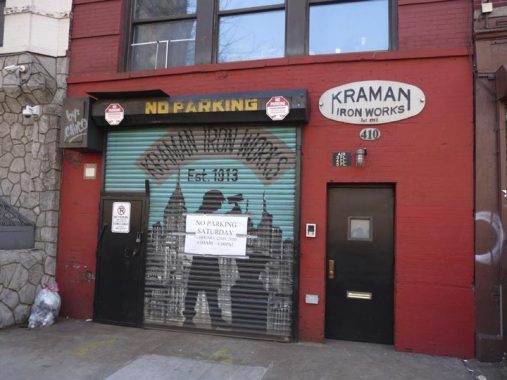
Before housing projects like the Jacob Riis and Lillian Wald Houses were built in the mid-20th Century, manufacturing and heavy industry joined tenement housing in the “far” East Village, such as the Kraman Iron Works which as the sign says was established in 1913.

Szold Place is a curious two-block road between East 10th and 12th Streets east of Avenue C. Until 1951, when it was surrounded by factories, mills and iron works, Szold Place was known as Dry Dock Street, after the nearby dry dock at the East River. These days, Szold Place is fairly drab, lined by nondescript high rise apartments and PS 34. The old name, however, lives on at Dry Dock Playground, on Szold Place north of East 11th. There was also Dollar Dry Dock Savings Bank, established in 1848 and liquidated in 1995 after absorption by Emigrant.
The name commemorates Henrietta Szold, the founder of the Jewish Zionist women’s organization Hadassah in 1912.
Keepers Storage, #444 East 10th, is housed in an Art Deco-era building festooned with interesting terra cotta panels. It was built in 1928 as the Wheatsworth Bakery and is a landmarked structure.

East 10th Street continues through the Jacob Riis Houses to the FDR Drive. Beyond that, we see the new high rise towers on the Williamsburg, Brooklyn waterfront.
I returned to Penn Station and the train home via 11th and 18th Streets, but FNY’s adventures there will be noted on another Cross Streets page.
Check out the ForgottenBook, take a look at the gift shop, and as always, “comment…as you see fit.”
4/26/20


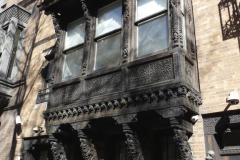
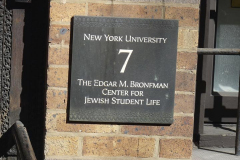

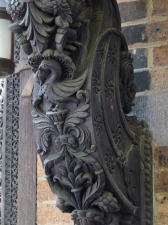
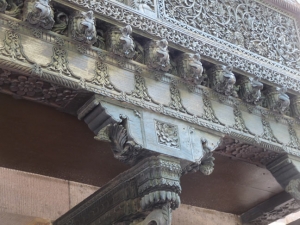
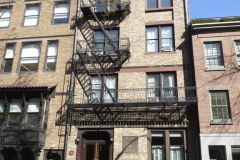
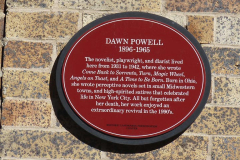
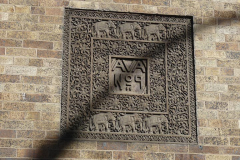
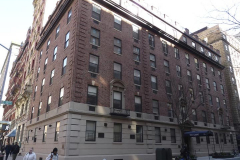
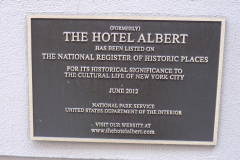
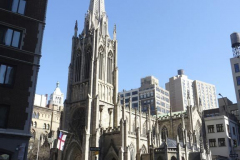
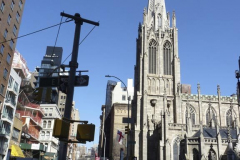



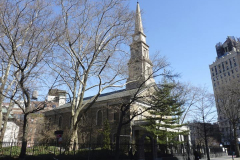


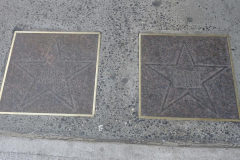
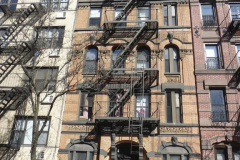
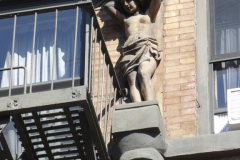

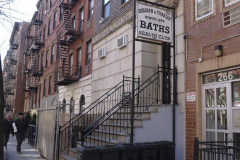

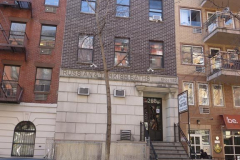
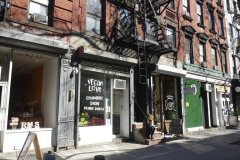
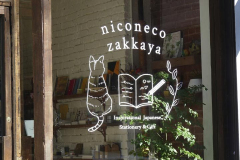
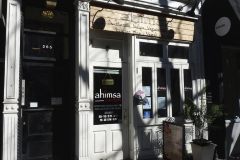

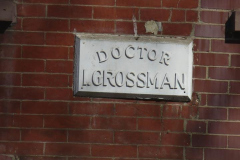

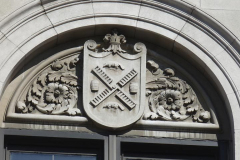

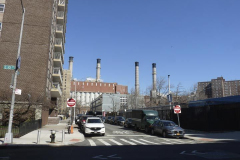
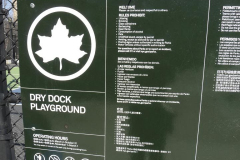
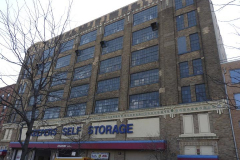
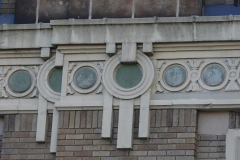
13 comments
162 Avenue B was once the location of the best dive bar in the city, the late, great and much lamented Lakeside Lounge. This joint had the best jukebox bar none.
Lockwood de Forest is an awesome name.
This is so fabulous! Like i emailed you Gene, I grew up at 15 East 10 St, Apt. 3B, from about 1951 (3rd grade) thru 1960 when I went away to college, and then for ab–out a year after I graduated. At some point they kicked everyone out of the building in the early 70’s I think, to make small apartments out of the nice size apts. that were in the bldg. then. Good old NY real estate! And one of my best friends at the time lived at 21 E 10. We used to have fun exploring all the alley ways between the buildings..
..But they only renovated the inside of 15 E 10 and kept the beautiful exterior.
My second attempt with a comment, hope this one goes thru.
This is great Gene, because like i emailed you, I grew up in Apt 3B, 15 East 10 St. in the 50’s. At some point in the early 70’s they kicked everyone out and made small apts. out of the nice sizes that existed when I was there. But they left the beautiful exterior. My close friend at the time lived at 21 E 10 St, and we used to have fun exploring the alley ways between the buildings..
Thanks for these beautiful photos!
Remember, comments appear when I get the chance to review and approve.
Thank you for all of this! I’m a big fan.
I lived at 35 E 10 Street for years. I believe it was renovated from two former factory loft buildings in the late 70s/ early 80s. Great block to live on. I have heard that 10th Street is the longest east/west street in Manhattan. Is this true?
Williamsburg Brooklyn is directly across the East River from the Jacob Riis Houses, not LIC.
A couple of notes:
The establishment Maiden Lane is located where the famous Life Cafe was for many years. The hit Broadway musical RENT was based on that place. https://www.nydailynews.com/life-style/eats/space-housed-life-cafe-setting-rent-rent-ending-era-article-1.1027711
After PS 64 moved to it’s present location in a new building on Ave. B, the old building was left derelict by the city until a group of community activists took the place over and ran The Charas/El Bohio cultural program and rented rooms as rehearsal studios. I was in there a number of times. It wasn’t in the greatest of shape but it was a positive addition to the artistic community of the 1980’s East Village. Mayor Giuliani, staunch opponent of community run organizations like this, sold the building, over local objections, to a developer who still owns it to this day. Rather then make a deal with the now outraged community and make a multi-use facility, the developer has maintained a stubborn my way or the highway stance for 20 years now. DeBlasio tossed out the idea the city was ready to buy the property back but nothing has come of it. https://www.6sqft.com/development-dispute-over-p-s-64-in-the-east-village-continues-two-decades-later/
In the days when telephone numbers were three letters and four numbers, there was a DRYdock exchange in lower Manhattan. I remember reading a New Yorker column of a man who was musing about the implications ofDRYdock while waiting for his call to be completed. I have never lived in NYC, but the subject of telephone exchanges is endlessly fascinating for me.
I remember Tompkin Sq Park and the library from the 50s. Dad would take us to the park after leaving the library. We lived down on Ave D @ E12th.
You have incorrectly stated the name of the Eastern Orthodox Church on 10th Street and Avenue A as Saint Nicholas
of Myra Carpatho Russian Greek Orthodox Catholic Church. This implies the Church is Catholic, which it never has been. The
correct name is Saint Nicholas Carpatho Russian Orthodox Greek Catholic Church. The founders are ethnic Rusyns, a diasporic East Slavic group, one of the 3 original founders, besides Czechs and Slovaks, of the former Czechoslovakia. Their land was
known as Ruthenia. When it was a part of the old Austro-Hungarian Empire, the clergy were forced to recognize the Pope in
Rome, but allowed to keep their Orthodox practices, which included a married clergy. Their faith was renamed as either Uniate
or Greek Catholic. Today the church is known as Saint Nicholas of Myra Carpatho Russian Orthodox Church. The signage on the facade is old and has not been modified to reflect that, which is where the inaccuracy arises. I am a member of the parish.